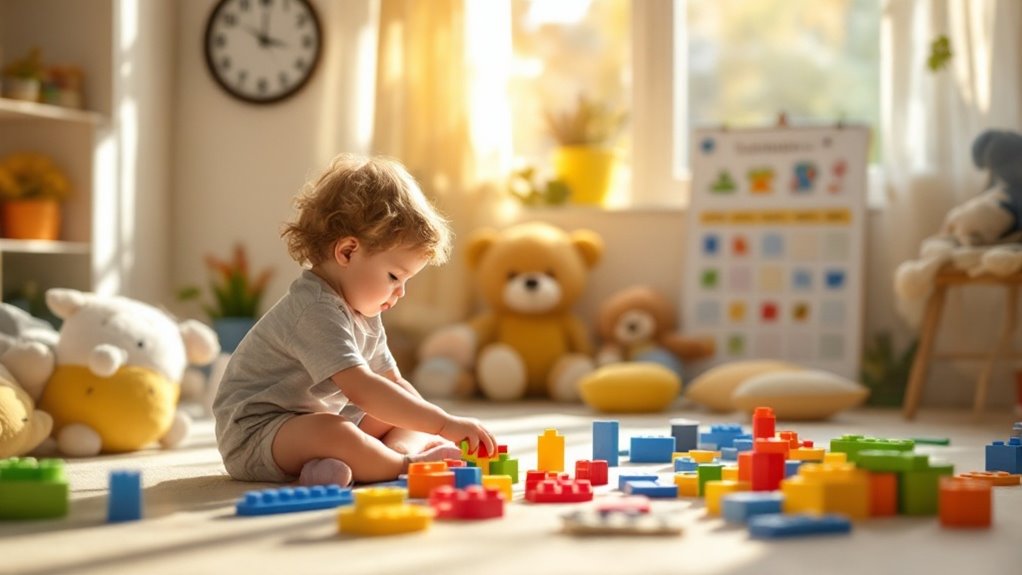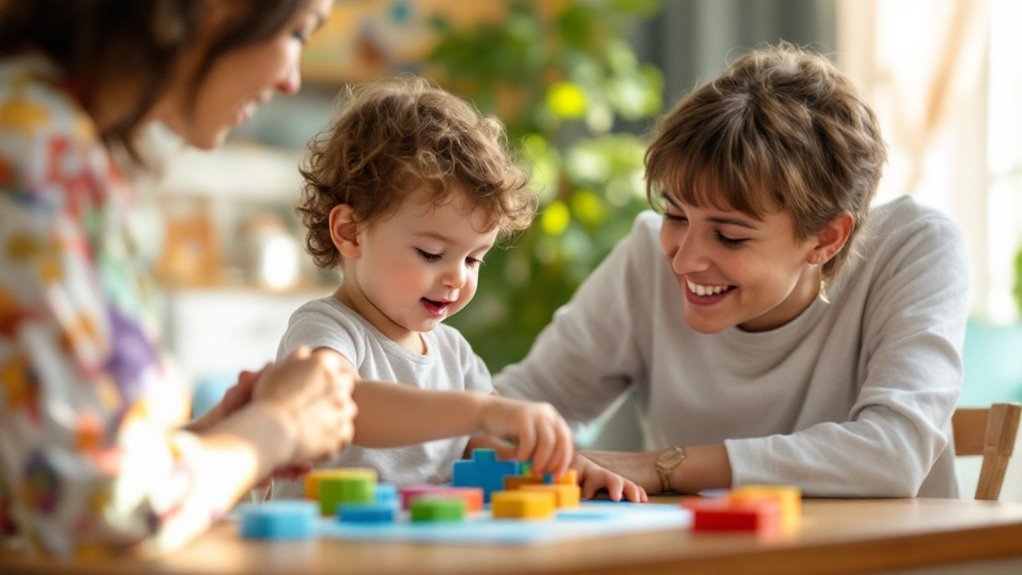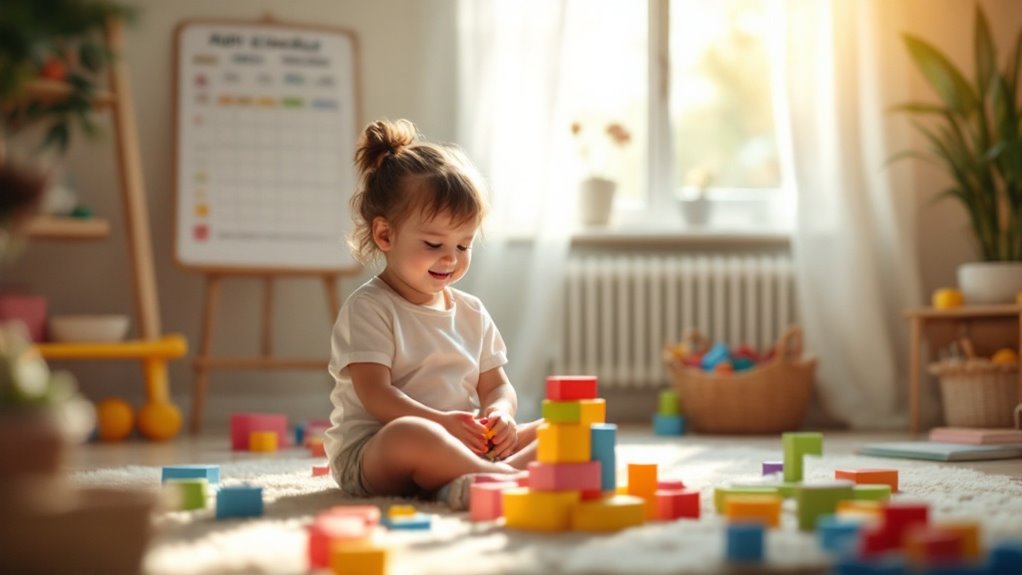It's interesting how both you and a parent of a child with autism might find yourselves discussing the same challenges around daily routines. You may not realize just how essential these routines can be for reducing anxiety and fostering independence in children with autism. Establishing a predictable schedule isn't just about order; it plays an important role in enhancing communication and social skills. But what happens when routines need to adapt to life's inevitable changes? Understanding this aspect could greatly impact a child's overall development and well-being.
Key Takeaways: Key Benefits of Routines for Children with Autism
- Routines provide predictability, reducing anxiety and creating a sense of security for children with autism.
- Structured daily activities enhance the development of life skills and independence.
- Visual schedules help children understand and prepare for daily events, aiding communication and reducing stress.
- Consistent routines foster positive family interactions, strengthening emotional bonds and social skills.
- Celebrating small successes within routines boosts confidence and encourages adaptability to changes.
Benefits of Routine

Establishing a routine can greatly benefit children with autism. When you create a consistent daily schedule, it helps your child understand what to expect throughout the day. This predictability can make changes smoother and enhance their sense of security. You'll notice that when your child knows what comes next, they're more likely to engage positively with activities and people around them.
Routines not only provide structure but also create opportunities for your child to develop important life skills. By incorporating tasks like getting dressed, brushing teeth, or doing homework into their daily schedule, you're helping them practice these skills regularly. Over time, they'll gain confidence in their abilities and become more independent.
Additionally, routines can enhance communication skills. By consistently using specific phrases or gestures during activities, you encourage your child to connect words with actions. This repetition reinforces their understanding and supports language development.
Finally, having a routine can make family interactions more enjoyable. When everyone knows the routine, it fosters a collaborative environment where you can spend quality time together, strengthening your bond and creating a sense of belonging for your child.
Reducing Anxiety and Stress
For children with autism, having a routine can substantially reduce anxiety and stress levels. When your child knows what to expect throughout the day, it creates a sense of security and control. Predictable schedules help them feel more at ease, minimizing the overwhelming feelings that can arise from unexpected changes or surprises.
By establishing a consistent routine, you provide your child with clear expectations. This reduces the mental load of figuring out what comes next, allowing them to focus on engaging with their activities. Incorporating visual schedules can further enhance this understanding, as they offer a tangible way for your child to track their day.
Moreover, routines can help you identify triggers that may lead to anxiety. By observing how your child reacts during specific activities, you can make necessary adjustments to alleviate stress.
Encouraging your child to participate in creating their routine can also empower them, boosting their confidence and sense of agency.
In this way, routines not only help in reducing anxiety but also foster a more relaxed atmosphere, allowing your child to thrive emotionally and socially. Consistency truly is key.
Enhancing Communication Skills

Consistently following a routine can greatly enhance communication skills in children with autism. When you establish a predictable daily structure, your child gains a sense of security that encourages them to express themselves more freely. Routines create opportunities for your child to learn and practice communication during specific times and activities, making it easier for them to understand when and how to engage.
For instance, you might set aside time each day for reading or playing games. This not only helps reinforce language skills but also teaches your child to associate certain activities with communication. Using visual aids, like schedules or picture cards, can further enhance this process, allowing them to visualize what's coming next and encouraging them to communicate their needs or thoughts.
Additionally, regular routines can lead to improved social interactions. When your child knows what to expect, they're more likely to participate in conversations and share their feelings.
Encouraging peer interactions during these routine activities can foster better communication skills, helping your child feel more comfortable expressing themselves. By prioritizing routines, you're setting the stage for meaningful exchanges and growing their confidence in communicating with others.
Promoting Independence
When you create a structured routine, you're not just providing stability; you're also fostering your child's independence. By establishing clear expectations and consistent sequences, you empower your child to take charge of their daily tasks. This predictability allows them to learn how to manage their time and make decisions about their activities.
For instance, you can break down daily chores into manageable steps. Encourage your child to follow the routine independently, allowing them to experience a sense of accomplishment. When they complete tasks like brushing their teeth or packing their backpack without your assistance, it boosts their confidence and self-reliance.
Additionally, routines can help your child learn how to prepare for changes. By incorporating visual schedules or checklists, you give them the tools to anticipate shifts in their day. This practice not only reduces anxiety but also teaches them to adapt and respond to new situations.
Ultimately, promoting independence through routine builds essential life skills. As your child becomes more self-sufficient, they'll gain the confidence needed to tackle challenges, paving the way for a more empowered future.
Embrace this journey, and watch them thrive!
Developing Social Skills

Building a structured routine not only enhances independence but also creates a foundation for developing social skills. When you establish consistent daily activities, your child gains confidence in knowing what to expect. This predictability helps them interact with peers more comfortably.
As you incorporate social interactions into their routine, you provide opportunities for practicing communication skills. For instance, set aside time for playdates or group activities where your child can engage with others. These interactions allow them to observe and mimic social cues, such as sharing and taking turns.
Encouraging conversations during routine activities, like mealtime or errands, also fosters their ability to engage with others. You can model appropriate responses and guide them in expressing their thoughts and feelings. Praise their efforts, no matter how small, to reinforce positive behaviors.
Additionally, consider role-playing different social scenarios at home. This practice can prepare your child for real-life interactions and reduce anxiety. The more they practice in a safe environment, the more comfortable they'll become in social situations outside the home.
Creating Visual Schedules
Creating visual schedules can greatly enhance your child's understanding of daily routines. By using pictures, symbols, or charts, you provide a clear representation of what to expect throughout the day. This visual aid helps your child anticipate changes, reducing anxiety and creating a sense of security.
To start, identify key activities in your child's daily routine, such as waking up, meals, playtime, and bedtime. Choose images that represent each activity, either by drawing them or finding pictures online. Assemble these images in sequential order to illustrate the day's flow.
Make sure the schedule is easily accessible, perhaps on a wall or a clipboard, so your child can refer to it whenever needed. Consistently using the visual schedule reinforces the routine, making it easier for your child to follow along.
You might consider using color coding or simple words alongside images to enhance understanding. Encourage your child to check off completed tasks, giving them a sense of accomplishment.
Involving Children in Routines

Involving your child in their daily routines fosters a sense of ownership and control over their environment. When your child actively participates, it helps them feel more engaged and reduces anxiety around changes.
You can encourage their involvement by allowing them to choose aspects of their routines. Here are some ideas to get started:
- Let them pick the order: Allow your child to decide the sequence of activities, like brushing teeth or getting dressed, which can make them feel more in charge.
- Use visual aids: Create a visual schedule together that outlines daily tasks, giving your child a clear understanding of what's coming next.
- Incorporate their interests: Include activities they enjoy, such as a favorite song during cleanup time, making routines more enjoyable and relatable.
Adapting Routines for Change
Adapting your child's routines for changes in their environment is crucial for maintaining their sense of stability. When unexpected events arise—like a family move, a new school, or changes in daily activities—it's essential to prepare your child. Start by discussing the changes ahead of time. Use visual aids or social stories to help them understand what to expect.
Incorporate familiar elements into the new routine. If possible, keep certain timeframes, activities, or shifts the same to provide familiarity. For example, if your child enjoys a specific morning ritual, maintain that even if the environment changes. This continuity can help ease anxiety and foster adaptability.
You should also be patient and flexible. Allow your child to express their feelings about the changes, and validate their emotions. It's okay if they take time to adjust; provide reassurance and support during this period. Monitor their responses and be ready to make further adjustments as needed.
Finally, celebrate small successes as your child adapts. Acknowledging their progress reinforces their resilience and makes shifts smoother for everyone involved.
Conclusion
Incorporating routine into your child's life isn't just a safety net; it's a bridge to confidence and growth. As you guide them through structured activities, you're not only reducing anxiety but also opening doors to communication and independence. Just like the steady beat of a drum, a consistent routine creates harmony in their daily life, allowing them to adapt to changes with ease. Embrace the power of routine, and watch your child flourish in a world of predictability.

